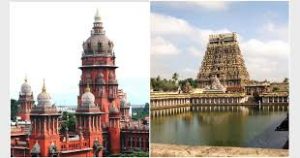Agamic temples:

The Supreme Court recently requested a committee formed by the Madras High Court to identify Agamic temples as against non-Agamic temples in Tamil Nadu in three months.
- The Agamas are a collection of scriptures of Hindu devotional schools.
- The term literally means tradition or “that which has come down”, and the Agama texts describe cosmology, epistemology, philosophical doctrines, precepts on meditation and practices, four kinds of yoga, mantras, temple construction, deity worship, and ways to attain sixfold desires.
- The origin and chronology of Agamas is unclear.
- The 3 main branches of Agama texts are Shaivism (of Lord Shiva), Vaishnavism (of Lord Vishnu), and Shaktism (of Adi Shakti).
- The Agamic traditions are sometimes called Tantrism, although the term “Tantra” is usually used specifically to refer to Shakta Agamas.
- The Agamas do not derive their authority from the Vedas, but are not antagonistic to them.
- They are all Vedic in spirit and character.
- That is the reason why they are regarded as authoritative.
- Many South Indian temples, especially in Tamil Nadu, follow Agamic traditions for daily rituals and festivals.




